The curl is also more pronounced. When I'm done with the sanding I'm debating between red mahogany and gunstock stains. Was considering cherry but it might be too light.certainly made the carving pop
You are using an out of date browser. It may not display this or other websites correctly.
You should upgrade or use an alternative browser.
You should upgrade or use an alternative browser.
Pendersoli Pennsylvania Longrifle Build
- Thread starter kje54
- Start date

Help Support Muzzleloading Forum:
This site may earn a commission from merchant affiliate
links, including eBay, Amazon, and others.
Certainly did
- Joined
- Nov 26, 2005
- Messages
- 5,355
- Reaction score
- 11,628
Hi Kje54,
Experimenting is fun!!! I do it all the time sometimes with the same results as you. I don't want to admit how many stocks I've wiped stain off of because my plan was a bust. Good on you to jump in and try carving. I find incised carving to be much more challenging than relief carving because you often cannot fix any mistakes and rough areas. It appears you used a "V" chisel. I can see where the heel dragged on some of the curves. The best incised carvers actually cut most of their scrolls with gouges. They stab in the design with a small flat chisel and then back cut the curves with gouges of the appropriate size for the curve. That results in much smoother curves. The rifle below has incised scroll cut with that method.
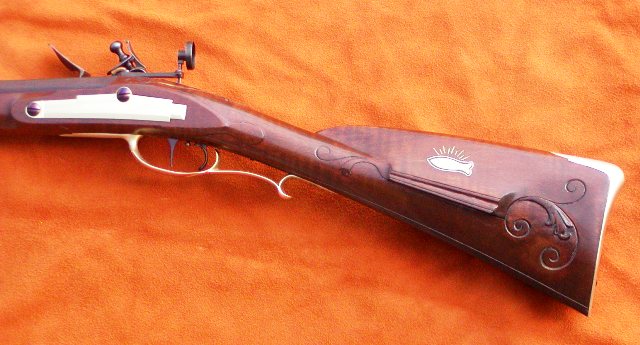
About staining English or European walnut. Your staining experiment will pay benefits but not in the way you originally intended. The dark pigment that will reside in the open rays of the wood will give the stock an old mellow look. Here is an example in which the English walnut stock was stained black first, scraped, and then stained with alkanet root infused in mineral spirits.
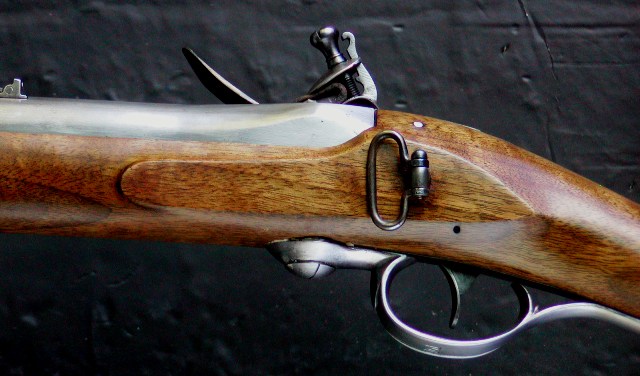
For staining and bringing out figure in English walnut, nothing beats alkanet root. Do an internet search and you will find vendors who sell the stain. Here is a figured English walnut stock stained with alkanet root.
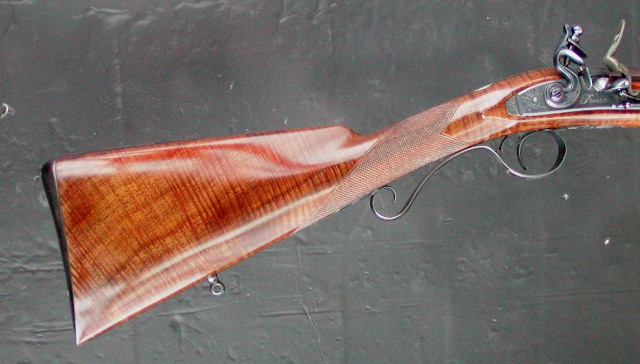
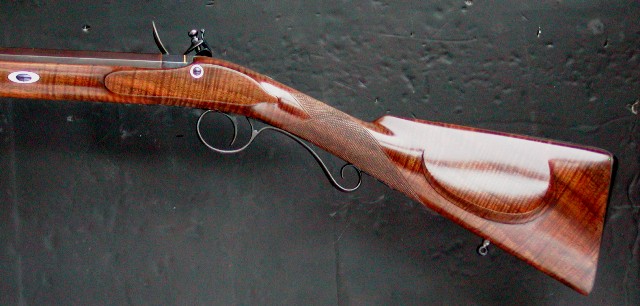
However, a really good alternative choice is Laurel Mountain Forge's walnut stain. Here is an example with English walnut.
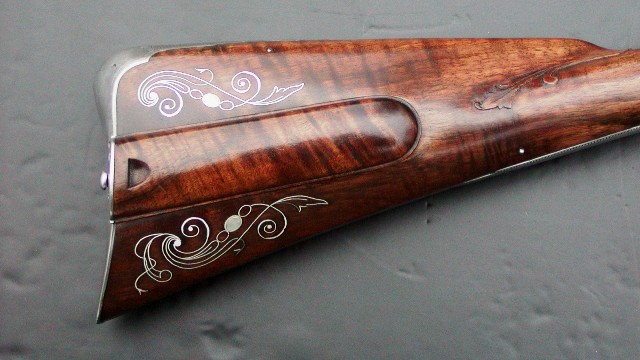
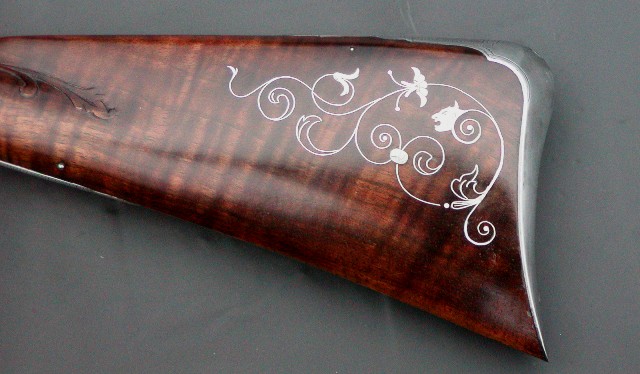
dave
Experimenting is fun!!! I do it all the time sometimes with the same results as you. I don't want to admit how many stocks I've wiped stain off of because my plan was a bust. Good on you to jump in and try carving. I find incised carving to be much more challenging than relief carving because you often cannot fix any mistakes and rough areas. It appears you used a "V" chisel. I can see where the heel dragged on some of the curves. The best incised carvers actually cut most of their scrolls with gouges. They stab in the design with a small flat chisel and then back cut the curves with gouges of the appropriate size for the curve. That results in much smoother curves. The rifle below has incised scroll cut with that method.

About staining English or European walnut. Your staining experiment will pay benefits but not in the way you originally intended. The dark pigment that will reside in the open rays of the wood will give the stock an old mellow look. Here is an example in which the English walnut stock was stained black first, scraped, and then stained with alkanet root infused in mineral spirits.

For staining and bringing out figure in English walnut, nothing beats alkanet root. Do an internet search and you will find vendors who sell the stain. Here is a figured English walnut stock stained with alkanet root.


However, a really good alternative choice is Laurel Mountain Forge's walnut stain. Here is an example with English walnut.


dave
Yup, used a "V" chisel, thought that was the way to go. Obviously not the best choice. I tried to keep it as straight as possible but didn't succeed.Hi Kje54,
Experimenting is fun!!! I do it all the time sometimes with the same results as you. I don't want to admit how many stocks I've wiped stain off of because my plan was a bust. Good on you to jump in and try carving. I find incised carving to be much more challenging than relief carving because you often cannot fix any mistakes and rough areas. It appears you used a "V" chisel. I can see where the heel dragged on some of the curves. The best incised carvers actually cut most of their scrolls with gouges. They stab in the design with a small flat chisel and then back cut the curves with gouges of the appropriate size for the curve. That results in much smoother curves. The rifle below has incised scroll cut with that method.

About staining English or European walnut. Your staining experiment will pay benefits but not in the way you originally intended. The dark pigment that will reside in the open rays of the wood will give the stock an old mellow look. Here is an example in which the English walnut stock was stained black first, scraped, and then stained with alkanet root infused in mineral spirits.

For staining and bringing out figure in English walnut, nothing beats alkanet root. Do an internet search and you will find vendors who sell the stain. Here is a figured English walnut stock stained with alkanet root.


However, a really good alternative choice is Laurel Mountain Forge's walnut stain. Here is an example with English walnut.


dave
Here's the stock with two coats of Gunstock stain.




I'm considering adding a side plate I've modified. It's still rough, not finished.


Awesome mr Person.Hi Kje54,
Experimenting is fun!!! I do it all the time sometimes with the same results as you. I don't want to admit how many stocks I've wiped stain off of because my plan was a bust. Good on you to jump in and try carving. I find incised carving to be much more challenging than relief carving because you often cannot fix any mistakes and rough areas. It appears you used a "V" chisel. I can see where the heel dragged on some of the curves. The best incised carvers actually cut most of their scrolls with gouges. They stab in the design with a small flat chisel and then back cut the curves with gouges of the appropriate size for the curve. That results in much smoother curves. The rifle below has incised scroll cut with that method.

About staining English or European walnut. Your staining experiment will pay benefits but not in the way you originally intended. The dark pigment that will reside in the open rays of the wood will give the stock an old mellow look. Here is an example in which the English walnut stock was stained black first, scraped, and then stained with alkanet root infused in mineral spirits.

For staining and bringing out figure in English walnut, nothing beats alkanet root. Do an internet search and you will find vendors who sell the stain. Here is a figured English walnut stock stained with alkanet root.
However, a really good alternative choice is Laurel Mountain Forge's walnut stain. Here is an example with English walnut.
dave
Thank you!
Finally put it together today. Not great but not that bad for an amateur carver.
Reworked the stock, comb, nose piece and added more period front and rear sights..... I just realized the front sight is on backwards...... Oops. Easy fix.




Reworked the stock, comb, nose piece and added more period front and rear sights..... I just realized the front sight is on backwards...... Oops. Easy fix.




Nice, I'd shoot it!
Finished up real nice!
SFH
SFH
Similar threads
- Replies
- 4
- Views
- 654
- Replies
- 4
- Views
- 991
- Replies
- 9
- Views
- 3K
- Locked
- Replies
- 22
- Views
- 3K



